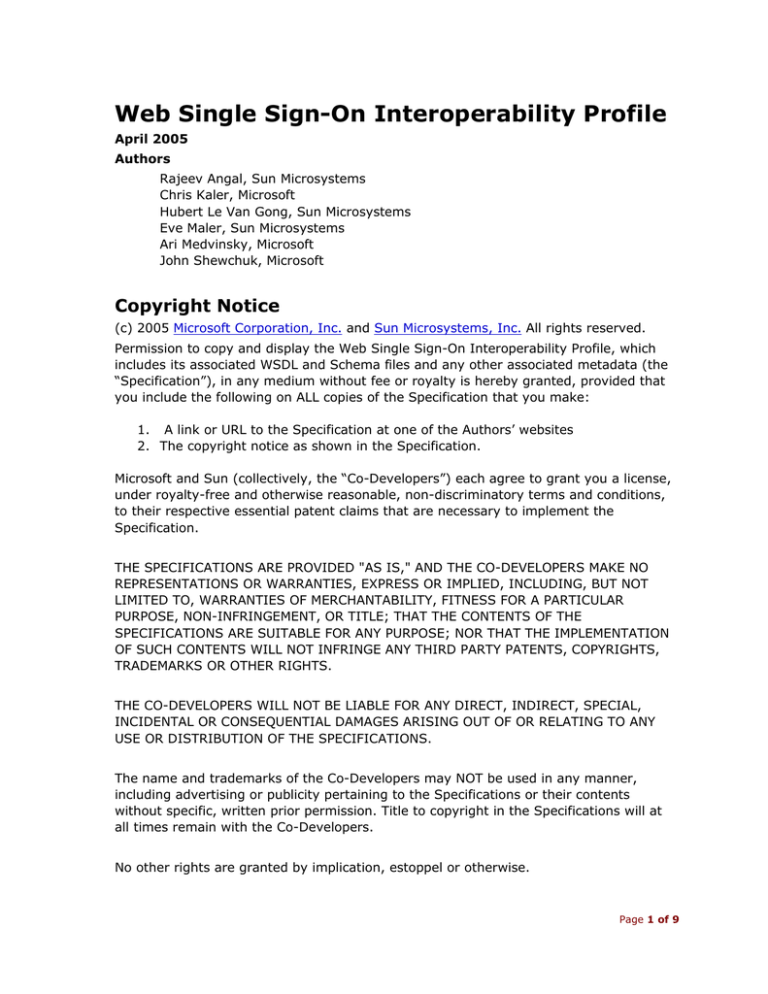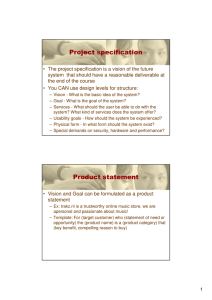
Web Single Sign-On Interoperability Profile
April 2005
Authors
Rajeev Angal, Sun Microsystems
Chris Kaler, Microsoft
Hubert Le Van Gong, Sun Microsystems
Eve Maler, Sun Microsystems
Ari Medvinsky, Microsoft
John Shewchuk, Microsoft
Copyright Notice
(c) 2005 Microsoft Corporation, Inc. and Sun Microsystems, Inc. All rights reserved.
Permission to copy and display the Web Single Sign-On Interoperability Profile, which
includes its associated WSDL and Schema files and any other associated metadata (the
“Specification”), in any medium without fee or royalty is hereby granted, provided that
you include the following on ALL copies of the Specification that you make:
1. A link or URL to the Specification at one of the Authors’ websites
2. The copyright notice as shown in the Specification.
Microsoft and Sun (collectively, the “Co-Developers”) each agree to grant you a license,
under royalty-free and otherwise reasonable, non-discriminatory terms and conditions,
to their respective essential patent claims that are necessary to implement the
Specification.
THE SPECIFICATIONS ARE PROVIDED "AS IS," AND THE CO-DEVELOPERS MAKE NO
REPRESENTATIONS OR WARRANTIES, EXPRESS OR IMPLIED, INCLUDING, BUT NOT
LIMITED TO, WARRANTIES OF MERCHANTABILITY, FITNESS FOR A PARTICULAR
PURPOSE, NON-INFRINGEMENT, OR TITLE; THAT THE CONTENTS OF THE
SPECIFICATIONS ARE SUITABLE FOR ANY PURPOSE; NOR THAT THE IMPLEMENTATION
OF SUCH CONTENTS WILL NOT INFRINGE ANY THIRD PARTY PATENTS, COPYRIGHTS,
TRADEMARKS OR OTHER RIGHTS.
THE CO-DEVELOPERS WILL NOT BE LIABLE FOR ANY DIRECT, INDIRECT, SPECIAL,
INCIDENTAL OR CONSEQUENTIAL DAMAGES ARISING OUT OF OR RELATING TO ANY
USE OR DISTRIBUTION OF THE SPECIFICATIONS.
The name and trademarks of the Co-Developers may NOT be used in any manner,
including advertising or publicity pertaining to the Specifications or their contents
without specific, written prior permission. Title to copyright in the Specifications will at
all times remain with the Co-Developers.
No other rights are granted by implication, estoppel or otherwise.
Page 1 of 9
Abstract
This document defines an interoperability profile of the web single sign-on metadata
exchange protocol [WSSOMEX] that allows using either Liberty Identity Federation or
WS-Federation based Identity Providers to interact with a service. It defines how the
service determines the protocols supported by the client’s identity provider thereby
allowing identity processing to occur.
Status
This specification is an initial public draft release and is provided for review and
evaluation only. The authors hope to solicit your contributions and suggestions in the
near future. The authors make no warrantees or representations regarding the
specifications in any manner whatsoever.
Table of Contents
1. Introduction
2. Notations and Terminology
2.1. Notational Conventions
2.1.1. Normative Outlines
2.2. XML Namespaces
2.3. Compliance
3. Protocol Suite Profile
3.1. Protocol Suites
3.2. SAML Profile
3.3. Liberty Identity Federation Profile
3.4. WS-Federation Passive Requestor Profile
4. Security Considerations
5. Acknowledgements
6. References
1. Introduction
This document describes a set of protocol suites that can be used with the Web Single
Sign-On Metadata Exchange Protocol.
It defines a notion of Target Service compliance and Identity Provider compliance.
2. Notations and Terminology
This section specifies the notations, namespaces, and terminology used in this
specification.
2.1. Notational Conventions
The keywords "MUST", "MUST NOT", "REQUIRED", "SHALL", "SHALL NOT", "SHOULD",
"SHOULD NOT", "RECOMMENDED", "MAY", and "OPTIONAL" in this document are to be
interpreted as described in RFC 2119 [RFC 2119].
Page 2 of 9
2.1.1. Normative Outlines
This specification uses the following syntax to define normative outlines for messages:
The syntax appears as an XML instance, but values in italics indicate data types
instead of values.
Characters are appended to elements and attributes to indicate cardinality:
"?" (0 or 1)
"*" (0 or more)
"+" (1 or more)
The character "|" is used to indicate a choice between alternatives.
The characters "[" and "]" are used to indicate that contained items are to be treated
as a group with respect to cardinality or choice.
An ellipsis (i.e. "...") indicates a point of extensibility that allows other child or
attribute content. Additional children and/or attributes MAY be added at the indicated
extension points but MUST NOT contradict the semantics of the parent and/or owner,
respectively. If an extension is not recognized it SHOULD be ignored.
XML namespace prefixes (see [XML-ns]) are used to indicate the namespace of the
element being defined.
Additionally, normative text is provided describing elements and attributes, their
expected values, and any usage expectations and restrictions. Normative text within this
specification takes precedence over normative outlines, which in turn take precedence
over any XML Schema and WSDL descriptions that are provided here or referenced from
other specifications.
2.2. XML Namespaces
The XML namespace URI that MUST be used by implementations of this specification is:
http://schemas.xmlsoap.org/ws/2005/04/ssi
where ssi refers to Single Sign-on Interoperability.
The following table lists XML namespaces that are used in this specification. The choice
of any namespace prefix is arbitrary and not semantically significant.
Prefix
XML Namespace
Specification(s)
ssi
http://schemas.xmlsoap.org/ws/2005/04/ssi
This document
xs
http://www.w3.org/2001/XMLSchema
XML Schema [Part 1, 2]
2.3. Compliance
A target service or identity provider is not compliant with this profile if it fails to satisfy
one or more of the MUST or REQUIRED level requirements defined herein. A SOAP Node
MUST NOT use the XML namespace identifier for this specification (listed in Section 2.2)
within SOAP Envelopes unless it is compliant with this specification.
This specification references a number of other specifications (see the table above). In
order to comply with this specification, an implementation MUST implement the portions
of referenced specifications necessary to comply with the required provisions of this
profile. Additionally, the implementation of the portions of the referenced specifications
that are specifically cited in this specification MUST comply with the rules for those
portions as established in the referenced specification. It is not necessary for
Page 3 of 9
compliance with this specification to implement portions of referenced specifications that
are not (directly or transitively) identified by this specification.
Additionally normative text within this specification takes precedence over normative
outlines (as described in section 2.1.1), which in turn take precedence over the XML
Schema [XML Schema Part 1, Part 2] and WSDL [WSDL 1.1] descriptions. That is, the
normative text in this specification further constrains the schemas and/or WSDL that are
part of this specification; and this specification contains further constraints on the
elements defined in referenced schemas.
3. Protocol Suite Profile
The following sections provide specific details and restrictions on the indicated
specifications to support the model defined in the Web Single Sign-On Metadata
Exchange Protocol [WSSOMEX].
This profile defines a subset of mechanisms for interoperability between WS-Federation
and Liberty Identity Federation (ID-FF) based applications.
Specifically:
•
Section 3.1 describes a set of required protocol suites.
•
Section 3.2 describes an interoperable subset of the SAML profile that a
compliant implementation MUST support
•
Section 3.3 describes an interoperable subset of Liberty ID-FF protocols that a
compliant implementation MUST support
•
Section 3.4 describes an interoperable subset of the WS-Federation Passive
Requestor Profile that a compliant implementation MUST support
This profile brings into scope the following specifications:
•
Assertions and Protocols for the OASIS Security Assertion Markup Language
(SAML) V1.1 [SAML]
•
WS-Addressing [WS-Addressing]
•
Liberty ID-FF Bindings and Profiles Specification, Version 1.2 [IDFFBP]
•
WS-Federation Passive Requestor Profile [WSFRP]
•
WS-MetadataExchange [MEX]
•
WS-Security [WS-Security]
3.1. Protocol Suites
The following protocol identifiers are defined:
Identifier
Meaning
<ssi:ID-FF_12/>
The Liberty 1.2 identity establishment and verification protocols are
supported as profiled below.
<ssi:WSFed_10/>
The WS-Federation 1.0 identity establishment and verification
protocols are supported as profiled below.
A compliant target service implementation MUST support both protocol suites; this
ensures maximum reach for the target service.
Page 4 of 9
A compliant identity provider implementation MUST support both protocol suites; this
ensures maximum reach for the identity provider.
Note that as described in the WebSSO metadata exchange protocol [WSSOMEX] in the
case where both the target service and the identity provider support both protocol suites
it is up to the target service to select its preferred protocol.
3.2. SAML Profile
Identification: http://schemas.xmlsoap.org/ws/2005/04/ssi
Contact Information: webssoq@Microsoft.com, Eve.Maler@Sun.COM
SAML Confirmation Method Identifiers: urn:oasis:names:tc:SAML:1.0:cm:bearer.
Description: Given below.
Updates: None.
In order to facilitate interoperability, this profile uses SAML assertions to convey identity
information, as defined in [SAML] and profiled here.
Only identity and name/value type claims are supported. The notion of “claims” is
modeled in SAML as an “assertion statement”. So an “identity claim” is expressed via an
AuthenticationStatement, and a “name/value” claim is expressed via an
AttributeStatement. The SAML assertion issued by the assertion provider in this profile
must carry an identity claim in the AuthenticationStatement (via the
Subject/NameIdentifier element) and may carry any number of name/value type claims
in the AttributeStatement.
To express Group claim semantics, the name/value claim syntax MUST be used as
described in the below:
# Claim Definition
Claim usage in SAML
1 Claim name: group
SAML Example:
<AttributeStatement>
URL: http://schemas.xmlsoap.org/2004/06/webSSO/group
<Subject>...</Subject>
<Attribute AttributeName=”group”
Description: the group claim. The group claim can only be
carried in the attribute element of AttributeStatement. (It is never
used in the Subject/NameIdentifier element).
AttributeNamespace=”http://schemas.xmlsoap.org
/2004/06/webSSO/group”>
<AttributeValue>Managers</AttributeValue>
</Attribute>
</AttributeStatement>
It should be noted that if there are privacy concerns around passing identity or any
statements made, care should be taken to protect this information.
The error codes defined in SAML, WS-Security, and SOAP are possible within this profile.
The following rules are established:
R-01)
Assertion providers MUST support, at a minimum, SAML 1.1 security
tokens
R-02)
SAML assertions MUST carry an identity claim in the authentication
statement via the Subject/NameIdentifier
R-03)
SAML assertions MAY carry any number of name/value type claims in the
AttributeStatement
R-04)
Group claims MUST use the syntax indicated in this document
Page 5 of 9
R-05)
The <saml:ConfirmationMethod> element of the assertion MUST be set
to the SAML V1.1 "Bearer" method:
urn:oasis:names:tc:SAML:1.0:cm:bearer
3.3. Liberty Identity Federation Profile
The interoperable profile of the Liberty Identity Federation browser federation protocol is
the Liberty Identity Federation Browser POST Profile, as described in section 3.2.3 of
[IDFFBP], with the restriction that WML is not supported.
The SAML assertion used is subject to the constraints defined above.
The following rules are established:
R-06)
The Liberty Identity Federation Browser POST Profile MUST be supported
R-07)
Support for WML is excluded from this profile
3.4. WS-Federation Passive Requestor Profile
The interoperable subset of WS-Federation Passive Profile is defined in the WSFederation Passive Requestor Interoperability Profile [WSFIP] document.
The WS-Federation Passive Requestor Interoperability Profile is a further constraint to
the Passive Requestor Profile [WSFRP].
The SAML assertion used is subject to the constraints defined above.
As defined in WS-Federation Passive Requestor Interoperability Profile to conform to this
specification, messages 1, 4, 7 & 10 must be supported. All other message exchanges
are implementation specific and are only provided in [WSFRP] for guidance.
The following rules are established:
R-08)
The WS-Federation Passive Requestor Profile MUST be supported
R-09)
The Passive Requestor Profile is further restricted to the subset identified
in WSFRP
4. Security Considerations
It is strongly recommended that the messages exchanged by Web services be secured
using WS-Security-based [WS-Security] mechanisms. In order to properly secure a
message, the SOAP body and all relevant SOAP header blocks need to be explicitly
included in the signature’s “signed data”. Specifically, any standard messaging header
blocks, such as those from WS-Addressing [WS-Addressing], need to be included in the
same signature as the SOAP body in order to "bind" them all together.
Additionally, different security mechanisms may be desired depending on the frequency
of message transmission. For example, for infrequent messages, public key technologies
applied to individual messages, as described above, may be adequate. However, for
high-frequency message transmissions, it may be more performant to establish a
security context between the endpoints. If a shared secret is used, it is RECOMMENDED
that derived keys be used to strengthen the secret.
Requests for metadata that are not available to anonymous parties are strongly
RECOMMENDED to require usage of WS-Security so that the requester can be
authenticated and authorized to access the indicated metadata. Similarly, integrity and
confidentiality SHOULD be used whenever metadata has restricted access.
Recipients of metadata are RECOMMENDED to validate the signature to authenticate and
verify the integrity of the data. Specifically, recipients SHOULD verify that the sender
Page 6 of 9
has the right to "speak" for the metadata. This is important because some metadata,
such as schemas, have embedded target URIs that might be outside the scope of the
sender.
If a metadata request results in a reference to another location, care should be taken if
that location is in a different security domain or realm from that of the original request
target.
It should be noted that when using URL parameters to indicate the identity providers
there is the possibility of a redirect attack by inserting a different identity provider that
the requestor expected (because the URL parameters are often not verified by users).
Constraints on the identity provider, additional security mechanisms, and/or user
interface should be used to mitigate against such attacks
The following list summarizes common classes of attacks that apply to this protocol and
identifies the mechanism to prevent/mitigate the attacks:
Message alteration – Alteration can be prevented through including signatures of
the message information using WS-Security mechanisms.
Message disclosure – Confidentiality can be preserved by encrypting sensitive data
using WS-Security mechanisms.
Key integrity – Key integrity can be maintained by using the strongest algorithms
possible.
Authentication – Authentication of messages can be established using the
mechanisms described in WS-Security.
Accountability – Accountability is a function of the type of and strength of the key
and algorithms being used. In many cases, a strong symmetric key provides
sufficient accountability. However, in some environments, strong PKI signatures are
required.
Availability – Metadata services are subject to a variety of availability attacks such
as application-level denial of service. It is recommended that the mechanisms
described in WS-Security be considered as mitigations for some forms of attacks.
Other attacks, such as network-level denial of service, are harder to avoid. Note that
both of these classes of attack are outside the scope of this specification.
Replay – Messages may be replayed for a variety of reasons. To detect and
eliminate this attack, mechanisms should be used to identify replayed messages
such as the timestamp/nonce outlined in WS-Security. Alternatively, and optionally,
other technologies, such as sequencing, can also be used to prevent replay of
application messages.
Privacy - Adequate privacy protections should be assured so as to inhibit the
unauthorized disclosure of personally identifiable information. In addition, controls
should be established so that personally identifiable information is not shared
without user notification and consent and that where applicable privacy regulations
may be accommodated.
5. Acknowledgements
This specification has been developed as a result of joint work with many individuals and
teams, including:
Qingwen Cheng (Sun)
Gary Ellison (Former co-author)
Page 7 of 9
Jeff Hodges (Former co-author)
Chuck Mortimore
Jeffrey Schlimmer (Microsoft)
Don Schmidt (Microsoft)
Wei Sun (Sun)
Emily Xu (Sun)
6. References
[IDFF]
Liberty ID-FF Architecture Overview, Version 1.2
[IDFFBP]
Liberty ID-FF Bindings and Profiles Specification, Version 1.2
[IDFFPS]
Liberty ID-FF Protocols and Schema Specification, Version 1.2
[MEX]
Keith Ballinger, et al, “Web Services Metadata Exchange (WS-MetadataExchange)”,
September 2004.
[RFC 2119]
S. Bradner, "Key words for use in RFCs to Indicate Requirement Levels," RFC 2119,
Harvard University, March 1997.
[RFC 2616]
R. Fielding, et al, "Hypertext Transfer Protocol -- HTTP/1.1," RFC 2616, UC Irvine,
June 1999.
[SAML]
Assertions and Protocols for the OASIS Security Assertion Markup Language (SAML)
V1.1
[SOAP 1.1]
D. Box, et al, "Simple Object Access Protocol (SOAP) 1.1," May 2000.
[SOAP 1.2]
M. Gudgin, et al, "SOAP Version 1.2 Part 1: Messaging Framework," June 2003.
[WS-Addressing]
D. Box, et al, "Web Services Addressing (WS-Addressing)," August 2004.
[WS-Policy]
S. Bajaj, et al, "Web Services Policy Framework (WS-Policy)," September 2004.
[WS-Security]
A. Nadalin, et al, "Web Services Security: SOAP Message Security 1.0 (WS-Security
2004)," March 2004.
[WSDL 1.1]
E. Christensen, et al, "Web Services Description Language (WSDL) 1.1," March 2001.
[XML Schema, Part 1]
H. Thompson, et al, "XML Schema Part 1: Structures," May 2001.
[XML Schema, Part 2]
P. Biron, et al, "XML Schema Part 2: Datatypes," May 2001.
[WSFED]
S. Bajaj, et al, “Web Services Federation Language (WS-Federation)”)
Page 8 of 9
[WSFRP]
S. Bajaj, et al, “WS-Federation Passive Requestor Profile”
[WSFIP]
WS-Federation Passive Requestor Interoperability Profile (as Passive Federation
Interop Scenario.doc)
[WSSAML]
OASIS Web Services Security: SAML Token Profile
[WSSOMEX]
Web Single Sign-On Metadata Exchange Protocol
[WSX]
OASIS Web Services Security: X.509 Certificate Token Profile;
Errata
[XML-ns]
W3C Recommendation, "Namespaces in XML," 14 January 1999
Page 9 of 9



